BEES IN MYTH AND MAGIC: Messengers Between Worlds
Long before written history, when gods still whispered through trees and rivers, there was the hum of bees. It was said their song carried messages between worlds – from the earth to the heavens – a rhythm of creation itself. People called them divine messengers, keepers of sweetness, and symbols of the soul’s immortality.
Even now, when we see a bee hovering over a flower, something ancient stirs in us – that quiet recognition of purpose, harmony, and sacred work.
The Bees of Ancient World: Carriers of Wisdom and Rebirth
In Greek mythology, bees were deeply woven into the fabric of divine stories.
The famous Minoan Gold Bee Pendant from Crete – two bees storing honey around a sacred drop – is one of the oldest known symbols of fertility, life, and creation.

Minoan Gold Bee Pendant, Crete
Bees appear across pantheons as companions of goddesses of fertility, birth, and wisdom – from Artemis, protector of women and the wild, to Cybele, the Great Mother of all life. Their hives mirrored divine order: a matriarchal world ruled by harmony, collaboration, and the leadership of the queen bee – a symbol of female sovereignty and sacred balance.
In ancient rituals, honey was offered to the dead as ambrosia, the food of the gods, signifying immortality and spiritual transformation.
To scholars and mystics, bees represented illumination – creatures that turned sunlight into wax and flame, symbolizing the birth of knowledge through devotion and patience.
The Universal Symbolism of the Bee
Across the world, bees carried sacred meaning, always returning to the same essence – creation, community, and the sacred feminine.
1. Melissa (Greek Mythology)
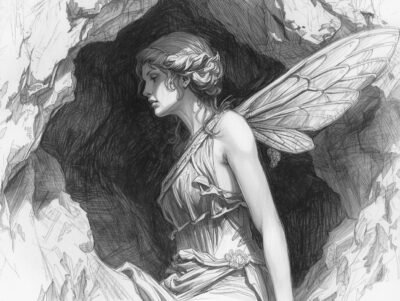
When the infant Zeus was hidden away from his father Kronos in a cave on Mount Dicte, a gentle nymph named Melissa fed him honey instead of milk – the nectar of immortality. In gratitude, Zeus transformed her into a bee, forever linking her to the rhythms of nourishment, devotion, and sacred service. Her name was later given to all the the priestesses of Demeter, goddess of fertility and the harvest, who were called Melissae. Through them, the bee became a living emblem of sacred femininity, purity, and service to the divine. Bees like the priestesses, were seen as channels between the human and the holy – between creation and renewal.
2. The Egyptian Bee (Symbol of Lower Egypt)
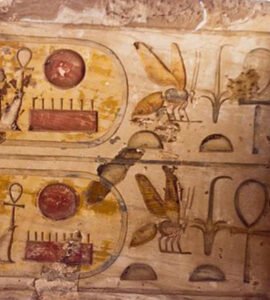
In ancient Egypt, the bee was a powerful symbol of Lower Egypt, embodying life, death, and resurrection. The sun god Ra, Egypt’s most revered deity, was said to shed tears that, upon touching the desert sands, transformed into honeybees – tireless workers and bringers of sweetness.
The Egyptians were also pioneers in beekeeping, crafting the first artificial hives to harvest honey. Hieroglyphs often show honeybees in reverence to Ra, honouring these tiny messengers and the golden treasure they produce – a sacred gift from the sun itself.
3. The Catholic Bee (Symbol of Resurrection and the Virgin Mary)
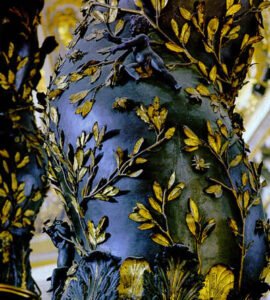
In Catholic tradition, the bee embodies diligence, purity, and divine order. The hive mirrors the Church itself – each bee working in harmony for a higher purpose, united under a Queen as believers under Mary, the Virgin Mother.
Because worker bees do not reproduce, they became symbols of virginity and devotion, while honey represents spiritual sweetness and divine wisdom. Early Christians carved beehives on tombs as signs of resurrection and eternal life.
Even the wax of church candles carries sacred meaning – the flesh of Christ, the wick His soul, the flame His divinity – transforming the bee’s humble labor into a living light of faith.
4. The Hindu Blue Bee (Vishnu, Krishna & Bhrāmarī Devi)
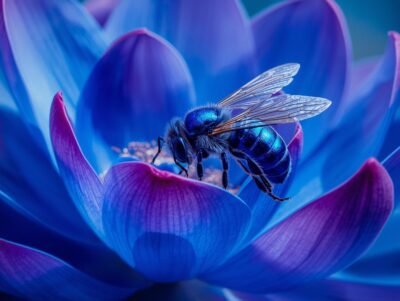
In Hindu mythology, bees symbolize life, rebirth, and divine harmony. The gods Vishnu and Krishna are often called Madhava, meaning “born of honey.”
The hum of bees was said to be the song of Kāma, the god of love, whose bow was strung with bees and whose arrows stirred desire and awakening. Their buzzing became a symbol of longing, tenderness, and the pulse of creation.
The Goddess Bhrāmarī Devi, an incarnation of the Great Mother Shakti, embodies the bee’s sacred power. Surrounded by swarms of black bees, she represents the feminine force that nurtures, protects, and restores balance – the hum of life itself made divine.
5. The Napoleonic Bee
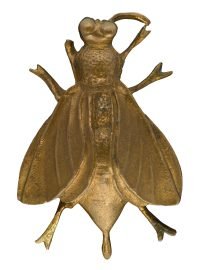
In the 19th century, Napoleon chose the bee as his emblem – a symbol of industriousness, vigilance, and order. Its association with hard work and the production of honey made it a fitting metaphor for diligence, benevolence, and grace. The bee also carried Christian connotations, representing the Church, eloquence, and divine virtue, as seen in the devotion of saints like St. Ambrose. Napoleon adorned everything from snuff boxes to his coronation robe with gilded bees, embracing their symbolism of zeal, productivity, and sweet authority – a tiny yet powerful emblem that conveyed both power and purpose.
6. The Manchester Worker Bee (modern symbol)
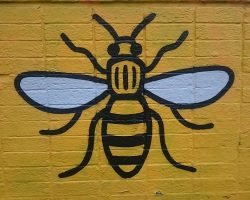
During the 18th and 19th centuries, Manchester became the heart of the Industrial Revolution, a city humming with innovation and production. Factories replaced handcraft, and machines drove progress – the streets and workshops abuzz with relentless activity. Locals began to liken these factories to beehives, where workers moved with purpose and coordination, each contributing to the collective effort. The worker bee, in particular, symbolizes the qualities of Mancunians, especially their work ethic and ability to work together for the common good. From this industrious energy, the bee became a lasting emblem of Manchester – a reminder of resilience, unity, and the power of community.
In every culture, bees embody the balance between work and wisdom, sweetness and sting, mortality and eternity.
Their hive mirrors divine order – a sacred reflection of the Mother Goddess herself, who governs through creation, connection, and care.
A Symbol That Still Speaks
The bee’s meaning has never faded.
It remains a reminder of creativity, cooperation, and the sacred rhythm of life – a tiny being capable of sustaining entire worlds.
From the gold of ancient pendants to the hum of a garden hive, bees continue to symbolize what humanity has always sought: connection, purpose, and transformation – the gentle power of the divine feminine alive in every act of creation.
Related Products
-
Melissa
109,00€ -
Melissa Gold
119,00€
Recent Posts
OUR NEWSLETTER
Subscribe to our newsletter and get 10% off your next purchase!



